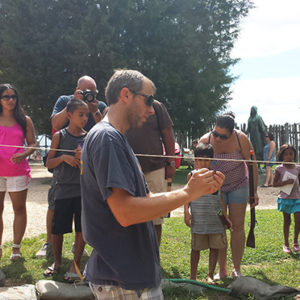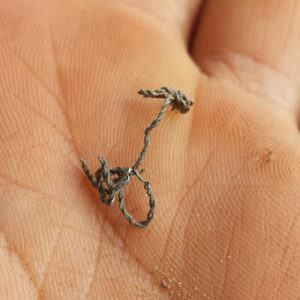Interesting artifacts started appearing even as Jamestown Rediscovery archaeologists did preliminary preparation of the large pit feature near the corner of the James Fort extension.
The archaeologists used trowels to clean the outlines of the pit so they could map its dimensions before beginning their detailed excavation of the feature this week. And artifacts began to appear.
“I can see some in the ground right now that we haven’t taken out yet,” said Staff Archaeologist Dan Smith. “There are artifacts sticking up everywhere.”
It’s possible that these artifacts and this summer’s other work in the open units by the Preservation Virginia welcome gate are pointing to an important structure—only the second fort period structure the Jamestown Rediscovery archaeologists have examined outside the James Fort’s original triangular palisade. The first was Structure 165, “The Factory” building outside the southeast bulwark of the fort that was investigated more than a decade ago.
“This ‘crater’ remains puzzling at this point, but the artifacts coming out now show how quickly the theories about a feature can change in an instant of trowel work in archaeology,” said Dr. William M. Kelso, Director of archaeological research and interpretation at Historic Jamestowne.
The prep work on the depression uncovered some silver wire, the fragment of a knife handle made of bone, Venetian glass trade beads, the kinds of copper scrap that colonists traded to Powhatan Indians, and a 16th century Spanish coin—all typical of the early James Fort period, said Jamestown Rediscovery Senior Staff Archaeologist Danny Schmidt.
In 2011 archaeologists followed the markings of a palisade wall jutting east off of the original James Fort’s eastern wall. Thought to be part of an extension that turned the original three-sided fort into one with five sides, a total of 69 feet of the wall was uncovered between excavations in 2003 and 2011.
Now the archaeologists may have found the terminus of that wall: 15 feet to the east of where they last dug that eastern palisade in 2011 sits a large posthole. That posthole—and other evidence that could indicate a cellar—may reveal a building at the corner of the five-sided version of the fort. Extending south of this corner is evidence of a palisade the team found last year running through the existing cemetery outside the 1907 Memorial Church.
Last year’s evidence of a building at the corner of the fort extension included postholes that were almost six feet deep. Other holes may be part of a wall that colony secretary William Strachey described as being planks and posts—a different style of construction than the palisade of the 1607 James Fort. The plank and post style is called a paling, and that kind of construction would lead to questions about how permanent the extension of the fort was meant to be, Kelso said.
The bowl-shaped depression now being investigated was full of broken bricks, some with mortar still on them. None of the bricks in this feature were intact, and they could be remnants from a 17th-century brick church that stood nearby. Those brick pieces have been completely removed from the feature now.
One of the artifacts that came out of the feature in the last week of August was a decorated tobacco pipe fragment. Dr. Beverly (Bly) Straube, Senior Archaeological Curator for the Jamestown Rediscovery Project, said the pipe is Virginia-made, burnished with a geometric rouletted design, and probably was made after 1640.
related images
- Archaeologist Danny Schmidt showing a pipe to visitors
- Copper coin in the conservation lab
- Dr. Kelso troweling in the pit feature just north of the 1907 Memorial Church
- Twisted silver wire strand









